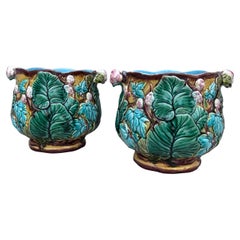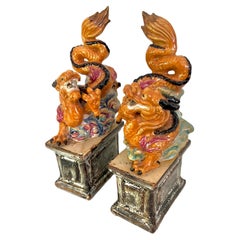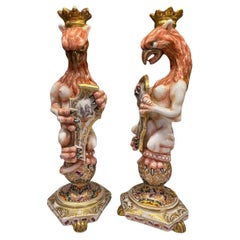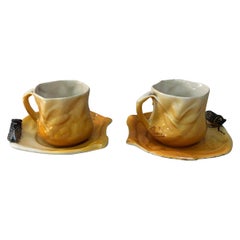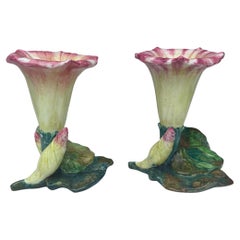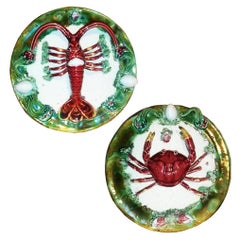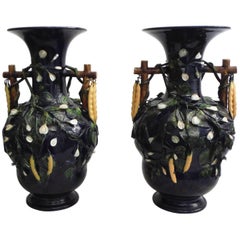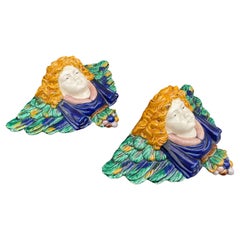Pair Of Majolica
to
103
606
143
760
2
1
89
45
42
10
10
6
6
5
3
3
2
2
1
19
446
293
3
113
115
14
18
6
9
5
12
35
13
2
4
668
434
384
61
43
699
299
180
139
120
759
759
759
30
11
10
9
8
Sort By
Pair of Majolica Flowers & Leaves Cache Pots Luneville Circa 1890
Located in Austin, TX
Pair of Majolica Flowers & Leaves signed Luneville Cache Pots Circa 1890,
H / 7 inches , D / 9
Category
Antique 1890s French Art Nouveau Planters, Cachepots and Jardinières
Materials
Ceramic, Majolica
$2,000 Sale Price / set
20% Off
H 7 in W 9 in D 7 in
Pair of Majolica Foo Dog Dragon Bookends
Located in Los Angeles, CA
A beautiful and brightly colored pair of Majolica Foo Dog or Dragon Bookends. The pieces are
Category
20th Century Asian Mid-Century Modern Bookends
Materials
Ceramic, Majolica
Capodimonte, 19th Century Italian Pair of Majolica Griffons
By Capodimonte
Located in North Miami, FL
Capodimonte 19th Century Italian opposing pair of majolica crowned and winged griffon figures. Both
Category
Antique 19th Century Italian Animal Sculptures
Materials
Porcelain
$3,160 Sale Price / set
20% Off
H 13 in Dm 5 in
Pair of Majolica Cups & Saucers With Cicada Sicart, Circa 1950
By Jacques Sicard
Located in Austin, TX
A pair of Majolica cups and plate with cicada signed Sicart, Circa 1950.
From South of France
Category
Vintage 1950s French Mid-Century Modern Serving Pieces
Materials
Ceramic
$320 Sale Price / set
20% Off
H 3.2 in W 4.8 in D 4.8 in
Pair of Majolica Morning Glory Vase Jerome Massier, circa 1900
By Jerome Massier
Located in Austin, TX
Pair of Majolica morning glory vases Jerome Massier, circa 1900.
The Massier family are known for
Category
Antique Early 1900s French Art Nouveau Vases
Materials
Ceramic, Faience, Majolica
$1,840 Sale Price / set
20% Off
H 6 in W 5.2 in D 5 in
Pair of Majolica Palissy Lobster and Crab Platters, circa 1940
Located in Mombuey, Zamora
Majolica Palissy Lobster and crab platters, circa 1940
Pair of Majolica wall plates with two
Category
Mid-20th Century Portuguese Decorative Art
Materials
Pottery
$720 Sale Price / set
38% Off
H 1.97 in W 9.06 in D 9.06 in
Rare Large French Pair of Majolica Palissy Beans Vases, circa 1880
By Saint Honore Les Bains
Located in Austin, TX
Remarkable oversize pair of Majolica vases decorated with beans in high relief attributed to Saint
Category
Antique 1880s French Victorian Vases
Materials
Majolica
$4,400 Sale Price / set
20% Off
H 17 in W 10.5 in D 10.5 in
Pair of Majolica Winged Angel Wall Brackets
Located in West Palm Beach, FL
Pair of decorative Angel Majolica wall brackets.
Category
20th Century Wall Brackets
Materials
Majolica
Large Pair of Majolica Terra Cotta Eagles
Located in Palm Beach, FL
Opposing pair of lifesize Majolica or glazed terra cotta eagles. Executed with fine detail right
Category
20th Century Italian Regency Animal Sculptures
Materials
Terracotta
Pair of Majolica Mushroom Tureen Pillivuyt, circa 1920
By Charles Pillivuyt & Cie
Located in Austin, TX
Pair of French green Majolica tureens with a mushroom on the handle signed Pillivuyt et Cie, circa
Category
Vintage 1920s French French Provincial Ceramics
Materials
Ceramic, Porcelain
Pair of Majolica Palissy Vases with Mistletoe, circa 1880
Located in Austin, TX
Palissy pair of small handled vases decorated with mistletoe, circa 1880.
The School of Paris was
Category
Antique 1880s French Victorian Vases
Materials
Majolica, Ceramic, Faience
$760 Sale Price / set
20% Off
H 5.5 in W 4 in D 5.5 in
Magnificent mid-century vintage pair of majolica pottery dragons
Located in Allentown, PA
This is a mid-century vintage magnificent pair of large majolica pottery dragons. This pair of
Category
Vintage 1980s Chinese Chinese Export Sculptures and Carvings
Materials
Pottery
19th Century Pair of Majolica Hunting Trophies Platters Onnaing
Located in Austin, TX
19th Century pair of large Majolica platters with hunting trophies Onnaing.
One with an hare
Category
Antique 1890s French French Provincial Decorative Art
Materials
Ceramic
$880 Sale Price / set
20% Off
H 1 in Dm 10.8 in
Pair of Majolica Palissy Chalices Vases with Grapes Circa 1880
Located in Austin, TX
Pair of 19th century Palissy chalices with lions heads and grapes garlands, the feets are stylized
Category
Antique 1880s French Renaissance Revival Serving Pieces
Materials
Majolica
$760 Sale Price / set
20% Off
H 6.3 in Dm 3.5 in
Pair of Majolica Palissy Vases with Butterflies Thomas Sergent, circa 1880
By Thomas Sergent
Located in Austin, TX
Pair of 19th century Palissy chalices vases with butterflies signed Thomas Sergent, the feets are
Category
Antique 1880s French Renaissance Revival Serving Pieces
Materials
Ceramic, Majolica
$640 Sale Price / set
20% Off
H 5.5 in Dm 2.6 in
Pair of Majolica Palissy Vases with Butterflies Thomas Sergent, circa 1880
By Thomas Sergent
Located in Austin, TX
Pair of 19th century Palissy chalices vases with butterflies signed Thomas Sergent, the feets are
Category
Antique 1880s French Renaissance Revival Serving Pieces
Materials
Majolica, Ceramic
$520 Sale Price / set
20% Off
H 4.3 in Dm 2.5 in
Pair of Majolica Palissy Vases with Butterflies Thomas Sergent, circa 1880
By Thomas Sergent
Located in Austin, TX
Pair of 19th century Palissy chalices vases with butterflies signed Thomas Sergent, the feets are
Category
Antique 1880s French Renaissance Revival Serving Pieces
Materials
Majolica
$520 Sale Price / set
20% Off
H 4.2 in Dm 2.6 in
Pair of Majolica Kingfisher and Lilies Vases Fives Lille, circa 1880
By Fives-Lille
Located in Austin, TX
Elegant 19th century French Majolica pair of vases attributed to Fives Lille.
The vases are shaped
Category
Antique 1880s French Aesthetic Movement Vases
Materials
Majolica, Ceramic, Faience
$2,000 Sale Price / set
20% Off
H 10 in W 4.8 in D 6.2 in
Unmatching Pair of Majolica Ceramic Trompe L'oeil Crab Lobster Large Wall Plates
Located in Barcelona, ES
. Portugal, 1950s
Rare find.
A colorful pair of fine Majolica glazed ceramic plates with seafood trompe
Category
20th Century Portuguese Mid-Century Modern Platters and Serveware
Materials
Majolica, Ceramic
$2,963 / set
H 3.55 in Dm 12.8 in
Pair of Majolica Ceramic Pelican Birds in Yellow Cream and Black, a Pair
Located in Oklahoma City, OK
A pair of tall handmade hand-painted ceramic majolica pelican birds. Each bird is glazed in cream
Category
20th Century American Hollywood Regency Animal Sculptures
Materials
Ceramic, Paint
$440 Sale Price / set
20% Off
H 10 in W 3.5 in D 7 in
Morroni & Tega Gualdo Tadino Rinascimental Italian Majolica Pair of Plates
By Morroni & Tega Gualdo Tadino
Located in Brescia, IT
Pair of Majolica plates.
Rinascimental décor.
Perfect condition.
Category
Vintage 1930s Italian Renaissance Decorative Art
Materials
Majolica
$3,556 / set
H 17.72 in W 2.17 in D 22.45 in
Pair of Antique 19th Century Majolica Jardinières
Located in New Orleans, LA
This pair of Majolica jardinieres are nicely crafted and would add a decorative element to a garden
Category
Antique Late 19th Century English Planters and Jardinieres
Materials
Majolica
Pair of Hand Painted Majolica 'Fish' Wall Appliques - Italy - Mid 20th Century
Located in Chatham, ON
Pair of majolica 'fish form' wall appliques - large size - molded form - each distinctly hand
Category
Mid-20th Century Italian Mid-Century Modern Decorative Art
Materials
Ceramic, Majolica
$812 Sale Price / set
30% Off
H 10 in W 12 in D 1.25 in
Pair of Palm Motif Majolica Glazed Vases With Dolphin Base
Located in Locust Valley, NY
This pair of Majolica glazed vases features an intricate palm motif with striking green foliage
Category
Mid-20th Century Unknown Victorian Vases
Materials
Ceramic, Majolica
Set of Six Majolica Glazed Asparagus Serving Plates
Located in LA CIOTAT, FR
A charming set of six earthenware hand-painted square asparagus plates, with a pair of Majolica
Category
Antique Early 1900s French Country Dinner Plates
Materials
Majolica, Porcelain
Pair of Early 20th Century Ceramic Barbotine Seashells Wall Hanging Plates
Located in Dallas, TX
This colorful pair of Majolica wall hanging plates was sculpted in France, circa 1920. Perfect for
Category
Early 20th Century French Decorative Art
Materials
Majolica
$425 / set
H 2 in Dm 8.5 in
Compatible Pair Of 19th Century Majolica Ceramic Lidded Urns Mounted As Lamps
Located in Bridgeport, CT
Compatible pair of Majolica ceramic lidded urns hand painted with floral bouquets, baskets, foliate
Category
Antique 19th Century French French Provincial Table Lamps
Materials
Ceramic
$4,600 / set
H 30 in W 14 in D 6.5 in
Pair Large Rare Red and Blue Figural Swimming Maiden Majolica Two Piece Planter
Located in Swedesboro, NJ
This pair of large and rare Majolica planters is a true collector’s treasure, showcasing exquisite
Category
Vintage 1920s Spanish Neoclassical Revival Planters, Cachepots and Jardi...
Materials
Majolica
$4,600 Sale Price / set
20% Off
H 57.25 in W 20 in D 22 in
Pair of 20th Century Italian Hand-Painted Porcelain Capodimonte Wall Platters
By Capodimonte
Located in Dallas, TX
This beautiful pair of majolica wall plates would elevate any living room, kitchen, or dining room
Category
Late 20th Century Italian Mounted Objects
Materials
Majolica, Porcelain
$550 / set
H 1.5 in Dm 14 in
Pair of 20th Century Italian Hand-Painted Porcelain Figurine Statues
By Capodimonte
Located in Dallas, TX
This beautiful pair of majolica figurines would elevate any living room, kitchen, or entry way
Category
Mid-20th Century Italian Figurative Sculptures
Materials
Majolica, Porcelain
$2,300 / set
H 30 in W 13 in D 9 in
French Faïence Longchamp Terre de Fer Hand-Painted Asparagus Plate
By Longchamp
Located in Philadelphia, PA
A French earthenware, hand painted square asparagus plate, circa 1890-1910.
A pair of Majolica
Category
Antique Late 19th Century French French Provincial Dinner Plates
Materials
Earthenware
Pair of Thomas Minton Majolica Jardinières
By Thomas Minton
Located in Stamford, CT
A beautiful pair of English Majolica jardinières by Thomas Minton. Shape numbers 1388 and 1389.
Category
Antique 17th Century English Planters, Cachepots and Jardinières
Materials
Majolica
Pair of Italian Majolica Busts, circa 1870
Located in New York, NY
Pair of Italian majolica busts, circa 1870.
Category
Antique Late 19th Century Italian Busts
Materials
Majolica
Pair of 19th Century Etruscan Majolica Leaf Plates
Located in Haddonfield, NJ
Highly collectable glazed Majolica plate in greens, yellow and pink. Wonderful ceramic pieces to
Category
Antique 19th Century English Rustic Ceramics
Materials
Ceramic, Majolica
Pair of Italian Majolica Lamps, circa 1875
Located in New York, NY
Urbino majolica lustre glazed scroll handled vases mounted as lamps.
Height of vase 15.5".
Category
Antique 1870s Table Lamps
Materials
Majolica
Pair of Minton Majolica Dove Flower Holders
By Minton
Located in Chelmsford, Essex
Pair of Minton Majolica flower holders which feature a fantail pigeon, standing on a leafy base
Category
Antique 1870s English Victorian Vases
Materials
Majolica
Pair of Minton Majolica Spring Daffodil Vases
By Minton
Located in Chelmsford, Essex
Pair of Minton Majolica vases which feature daffodils stood on bulb feet. Cobalt blue ground
Category
Antique 1860s English Victorian Vases
Materials
Majolica
Pair of Turn of the Century Italian Majolica Harlequins
Located in Queens, NY
Pair of turn of the century Italian Majolica porcelain male and female
harlequin figures each
Category
Antique Late 19th Century Italian Figurative Sculptures
Materials
Majolica
Pair of Hugo Lonitz Majolica Satyr Vases
Located in Chelmsford, Essex
Pair of Hugo Lonitz Majolica vases which feature satyr masks to the side, with grape vine swags
Category
Antique 1880s German Victorian Vases
Materials
Majolica
Pair Majolica Swan Wall Pockets
By Adams & Bromley
Located in Chelmsford, Essex
Pair of Adams and Bromley (attributed) Majolica wall pockets which feature swans amongst cattails
Category
Antique Late 19th Century English Decorative Art
Materials
Majolica
Pair of French Majolica Pitchers or Vases
Located in Winter Park, FL
A pair of French Majolica vases or pitchers, each with double tree branch form handles and spouts
Category
Early 20th Century French Art Deco Vases
Materials
Majolica
Pair of 19th Century English Majolica Pickles Pitchers
Located in Austin, TX
Amusing pair of Victorian Majolica pickles pitchers signed dated with the English mark June 7th
Category
Antique 1870s English Victorian Pitchers
Materials
Majolica, Ceramic, Faience
$1,460 Sale Price / set
20% Off
H 9 in W 4 in D 6 in
Pair of French Majolica Rooster & Hen Circa 1890
By George Dreyfus
Located in Austin, TX
Pair of French Majolica Rooster & Hen attributed to George Dreyfus Circa 1890.
Hen : H / 8" ,5.5
Category
Antique 1890s French Rustic Animal Sculptures
Materials
Ceramic, Faience, Majolica, Pottery
$2,000 Sale Price / set
20% Off
H 10 in W 5.5 in D 3 in
Pair of 19th Century Italian Glazed Majolica Mirrors
Located in Bradenton, FL
Fine pair of 19th century baroque Italian Majolica glazed mirrors. Mirrors are hand- made featuring
Category
Antique 19th Century Italian Baroque Wall Mirrors
Materials
Majolica
Pair of White Majolica Ceramic Doves, Italy 1960s
Located in Clifton Springs, NY
distributor name in writing. We're attributing the pair to Mottahedeh, who sourced Italian majolica in similar
Category
Mid-20th Century Italian Animal Sculptures
Materials
Ceramic, Majolica, Pottery
Pair of 19th Century English Majolica Bamboo Vase
By Minton
Located in Austin, TX
19th Century Pair of English Majolica vases bamboo with a pink bow.
Category
Antique 1890s English Victorian Vases
Materials
Ceramic, Faience, Majolica
Pair of German Majolica Lady And Gent Figures
Located in Chelmsford, Essex
Pair of German Majolica figurals which feature a well dressed lady and gentleman, walking a dog
Category
Antique 1880s German Victorian Figurative Sculptures
Materials
Majolica
Pair of Massive Framed Italian Majolica Chargers, circa 1880
Located in New York, NY
Finely painted in an Italian palette with mythological and Roman battle scenes, each border rim painted with yellow enamel. With a large carved ebony frame. Dimension of frame 34.5" ...
Category
Antique 1880s Italian Decorative Art
Materials
Majolica
Pair of Antique English Majolica Pedestals by Wedgwood
By Wedgwood
Located in London, GB
Pair of antique English majolica pedestals by Wedgwood
English, 1877
Height 86cm, diameter 40cm
Category
Antique Late 19th Century English Victorian Pedestals
Materials
Majolica
Pair of 19th Century Austrian Majolica Pepper Platter Johann Maresh
By Johann Maresch
Located in Austin, TX
Small Pair of 19th Century Austrian Majolica Pepper Platter Johann Maresh.
6.3 by 4.3 inches.
Category
Antique 1890s Austrian Black Forest Decorative Art
Materials
Ceramic, Majolica
$680 Sale Price / set
20% Off
H 6.3 in W 4.3 in D 1.5 in
French Fives-Lille De Bruyn Morning Glory & Butterfly Wall Pockets, 1890, a Pair
By Fives-Lille
Located in Philadelphia, PA
A pair of majolica glazed French Morning Glory wall pockets, Fives-Lille, circa 1890.
Fives-Lille
Category
Antique Late 19th Century French Aesthetic Movement Wall-mounted Sculptures
Materials
Earthenware
$3,200 / set
H 14.5 in W 7 in D 5.5 in
Pair of Mid-Century Italian Majolica Fruit Cornucopia Arrangements Centerpieces
Located in Pearland, TX
A lovely pair of vintage Mid Century Italian majolica fruit cornucopia, or horn of plenty
Category
Mid-20th Century Italian Centerpieces
Materials
Majolica
$750 / set
H 11 in W 6 in D 6 in
Pair of 19th Century Majolica Vases Choisy Le Roi
By Choisy-le-Roi
Located in Austin, TX
Pair of 19th Century Majolica Vases signed Choisy Le Roi.
The manufacture of Choisy le Roi was one
Category
Antique 1880s French Napoleon III Vases
Materials
Majolica, Ceramic
Sarreguemines French Majolica Pair of Vases with Ships, Vintage France
By Sarreguemines
Located in Nuernberg, DE
Beautiful pair of vases made by Sarreguemines France. Underglaze mark. Nice addition to your table
Category
Vintage 1930s French Folk Art Ceramics
Materials
Ceramic, Majolica
$280
H 8.25 in W 4.13 in D 2.63 in
Pair of French Majolica Table Lamps
Located in New York, NY
A pair of circa 1940s French Majolica porcelain in green glaze with foliage motif.
Measurements
Category
Vintage 1940s French Table Lamps
Materials
Porcelain
French Majolica Large Urns- A Pair
Located in Downingtown, PA
French Majolica Large Urns,
A Pair,
Circa 1870-90
The pair of French large majolica flower urns
Category
Antique 1870s French Arts and Crafts Urns
Materials
Majolica
Pair of Urbino Style Majolica Vases, Early 20th Century
Located in New York, NY
With entwined serpent handles, painted in colors on both sides of the bodies with biblical scenes.
Category
Early 20th Century Italian Vases
Materials
Majolica
- 1
- ...
Get Updated with New Arrivals
Save "Pair Of Majolica", and we’ll notify you when there are new listings in this category.
Pair Of Majolica For Sale on 1stDibs
With a vast inventory of beautiful furniture at 1stDibs, we’ve got just the pair of majolica you’re looking for. Each pair of majolica for sale was constructed with extraordinary care, often using ceramic, earthenware and majolica. There are 341 variations of the antique or vintage pair of majolica you’re looking for, while we also have 2 modern editions of this piece to choose from as well. There are many kinds of the pair of majolica you’re looking for, from those produced as long ago as the 18th Century to those made as recently as the 21st Century. A pair of majolica is a generally popular piece of furniture, but those created in Victorian, Art Nouveau and Mid-Century Modern styles are sought with frequency. You’ll likely find more than one pair of majolica that is appealing in its simplicity, but Minton, Jerome Massier and Sarreguemines produced versions that are worth a look.
How Much is a Pair Of Majolica?
A pair of majolica can differ in price owing to various characteristics — the average selling price 1stDibs is $1,975, while the lowest priced sells for $149 and the highest can go for as much as $120,000.
Questions About Pair Of Majolica
- What is a majolica jardiniere?1 Answer1stDibs ExpertApril 5, 2022A majolica jardiniere is an ornamental stand for holding planters and flower pots that is made out of a type of earthenware pottery called majolica. It has a high-gloss finish and vibrant colors achieved through the use of lead glaze. Shop a selection of jardinieres on 1stDibs.
- What is a majolica print?1 Answer1stDibs ExpertFebruary 17, 2023A majolica print is a print used on textiles, apparel and accessories that draws inspiration from majolica tin-glazed pottery produced during the Italian Renaissance. Often, the prints incorporate intricate scrollwork, fruit and flowers and show off vibrant blue, orange and yellow colors. Shop a variety of apparel and accessories on 1stDibs.
- What is antique majolica?1 Answer1stDibs ExpertApril 5, 2022Antique majolica is a type of Victorian earthenware characterized by beautifully-colored lead glazes. It first appeared in the 1850s and is highly sought after today. On 1stDibs, shop a collection of antique majolica from some of the world’s top sellers.
- What is a majolica plate?1 Answer1stDibs ExpertApril 5, 2022A majolica plate is a decorative piece of pottery that has a round flat shape. It is a heavy clay vessel that features a painted and glazed enamel finish. It emerged from 15th-century Italy but quickly became popular in Spain. Later examples come from Victorian England. On 1stDibs, shop a selection of majolica plates.
- What is Minton Majolica?1 Answer1stDibs ExpertApril 5, 2022Minton Majolica is a type of glazing process for pottery. Created at the Minton factory in London, Majolica is a low-temperature, colored lead glaze used on earthenware pottery. You’ll find a selection of antique Milton Majolica pieces from some of the world’s top dealers on 1stDibs.
- What is Palissy majolica?1 Answer1stDibs ExpertApril 5, 2022Palissy majolica is a combination of terms. Famed French potter Bernard Palissy’s ceramics were known as rusticware to him, but his novel polychrome lead-glazed look with naturalistic scenes were so highly regarded that the style became known as Palissyware. Centuries later, in the Palissy style, Minton & Co. created their Palissy ware, which later became known as majolica. Find a collection of expertly vetted Palissy art from some of the world’s top reputable boutiques on 1stDibs.
- What is Italian majolica?1 Answer1stDibs ExpertApril 5, 2022Majolica refers to tin-glazed pottery that features a white background with brightly colored hues painted on top. The colors are applied as underglazes or to the unfired glaze and then fired to hold them in place forever. This technique was widely used in the Renaissance period in northern and central Italy. Shop a range of antique and vintage majolica on 1stDibs.
- Is majolica a pottery?1 Answer1stDibs ExpertApril 5, 2022Yes, majolica is a type of pottery. Artisans produce it from a heavy clay with a rich brown color and then finish it with enamel, paint and glaze. The style of pottery emerged during the mid 19th century. Find a variety of majolica pottery on 1stDibs.
- 1stDibs ExpertNovember 4, 2024One of the easiest ways to identify vintage majolica is to use the maker's marks. Look at the bottom and interior of your piece and then consult trusted online resources to determine if it was produced by a maker well-known for making majolica, such as Wedgwood, Minton or George Jones. Once you have identified the maker, research further to determine the approximate age of your piece. You can consider it vintage if it is 20 to 99 years old. Alternatively, you can ask a certified appraiser or experienced antique dealer to evaluate your piece. On 1stDibs, explore an assortment of vintage majolica pottery.
- 1stDibs ExpertAugust 20, 2024The difference between majolica and talavera comes down to specificity. Majolica is the term for earthenware pottery finished with a specialty tin glaze. Talavera is a type of majolica that originated in the Talavera de la Reina area of Spain and later spread to Mexico. It typically features intricate, colorful floral patterns. Shop a selection of majolica and talavera pottery on 1stDibs.
- Is Bordallo majolica pottery?1 Answer1stDibs ExpertMarch 25, 2024Yes, Bordallo is majolica pottery. Majolica is the term for pottery that features a tin glaze and colorful details hand-painted on a white background. Bordallo Pinheiro is well known for using traditional Portuguese techniques to produce pottery in the majolica style. On 1stDibs, find a selection of Bordallo Pinheiro pottery.
- 1stDibs ExpertApril 5, 2022Majolica pottery comes primarily from Italy, Mexico and Spain. The earliest examples of the glazed pottery originate from Italy and date back to the Renaissance. By the 19th century, many workshops in Europe produced majolica pieces. On 1stDibs, shop a selection of majolica pottery.
- 1stDibs ExpertApril 5, 2022To tell if majolica is real, look closely at the glazed finish. If you notice uneven coloration, drips, runs or other imperfections, the pottery is unlikely to be authentic. On 1stDibs, you can shop a range of expertly vetted majolica pottery.
- 1stDibs ExpertOctober 7, 2024To know if your majolica is real, examine the glaze carefully. Authentic majolica will usually be free of flaws, while reproductions may display runs and drips. Keep in mind that majolica is a type of earthenware rather than a brand. Familiarizing yourself with the maker's marks and characteristics of the pieces associated with the artisan or factory that produced your pottery can help you determine what else to look for during the authentication process. If you'd like a professional opinion, consult a certified appraiser or knowledgeable antique dealer. On 1stDibs, explore a range of majolica pottery.
- 1stDibs ExpertApril 5, 2022There is no difference between maiolica and majolica pottery, they are simply variations of the same name. Majolica/maiolica is earthenware with a tin-glazed white enamel finish that was made in Italian. Other names for tin-glazed pottery are faience or delftware. Shop a large selection of Italian pottery on 1stDibs.
- 1stDibs ExpertOctober 7, 2024The difference between majolica and faience is largely a matter of geography and style. Both terms describe types of tin-glazed earthenware inspired by maiolica, ceramics made in Italy beginning in the 15th century. Majolica is the British take on maiolica. It emerged during the mid-19th century. Made by Minton and other companies, it is often playful and whimsical. Think of a sardine jar adorned with decorative sardines or a pie dish that resembles a real pie. Faience is the French version of maiolica. Artisans began producing it in the 16th century in the city of Rouen. However, it became especially popular during the late 19th century. Unlike the creative designs common among majolica pottery, faience tends to be more formal and draws inspiration from Persian, Japanese and Chinese ceramics. Explore a collection of majolica and faience pottery on 1stDibs.
- Is majolica worth anything?1 Answer1stDibs ExpertOctober 24, 2024Yes, some majolica is worth something. Many collectors seek out select pieces from well-known makers of tin-glazed earthenware, such as Wedgwood, George Jones and Minton, and rare items can sometimes sell for thousands of dollars. However, selling prices for majolica vary greatly based on age, type, style, condition and other factors. A certified appraiser or knowledgeable antique dealer can help you determine how much any pottery you own is worth. Shop a large selection of majolica pottery on 1stDibs.
- How do I pair palazzo pants?1 Answer1stDibs ExpertApril 5, 2022How you pair palazzo pants is largely a matter of personal preference. Many people choose to balance the flowy oversize shape of the pants with fitted tops, sweaters or turtlenecks. On 1stDibs, shop a selection of vintage and designer palazzo pants.
- 1stDibs ExpertApril 5, 2022For a casual look, pair your Versace dress shirt with a nice pair of jeans and your favorite pair of loafers or casual pumps. For a more dressy look, pair it with dress slacks or a fitted skirt and dress shoes or heels. Find authentic Versace pieces on 1stDibs.
- 1stDibs ExpertSeptember 9, 2024To tell how old a pair of glasses is, you can examine it closely and then conduct some research using trusted online resources. If you see a mark that indicates the maker, use the manufacturer as a starting point. Find out when the company was in business and look at catalogues and other references to determine when it produced similar styles. If you can't find a maker, your glasses will likely be from the late 20th century or earlier. In this case, you can research the characteristics of your glasses to get a rough idea of the age. For example, nose pads didn't come into use until the 1920s. Another feature of eyeglasses introduced in the 1920s is positioning the temples at the upper corners of the frames rather than in the middle. If you need help with dating, consult a certified appraiser or knowledgeable antique dealer. On 1stDibs, explore a collection of eyeglasses.
More Ways To Browse
Gurgle Jugs
Minton Garden Seat
Minton Seat
Vintage Green Glass Wine Bottle
White Ceramic Dove
Antique Majolica Garden Seats
Capodimonte Animal
Ceramic Wall Hanging Plate
Majolica Horse
Majolica Palm
Italian Faience Urns
Large Pink Blue Vase
Majolica Deer
Reticulated White Lamp
Emile Hugo
Gurgle Vase
Gurgling Fish Vase
Hugo Lonitz Majolica
